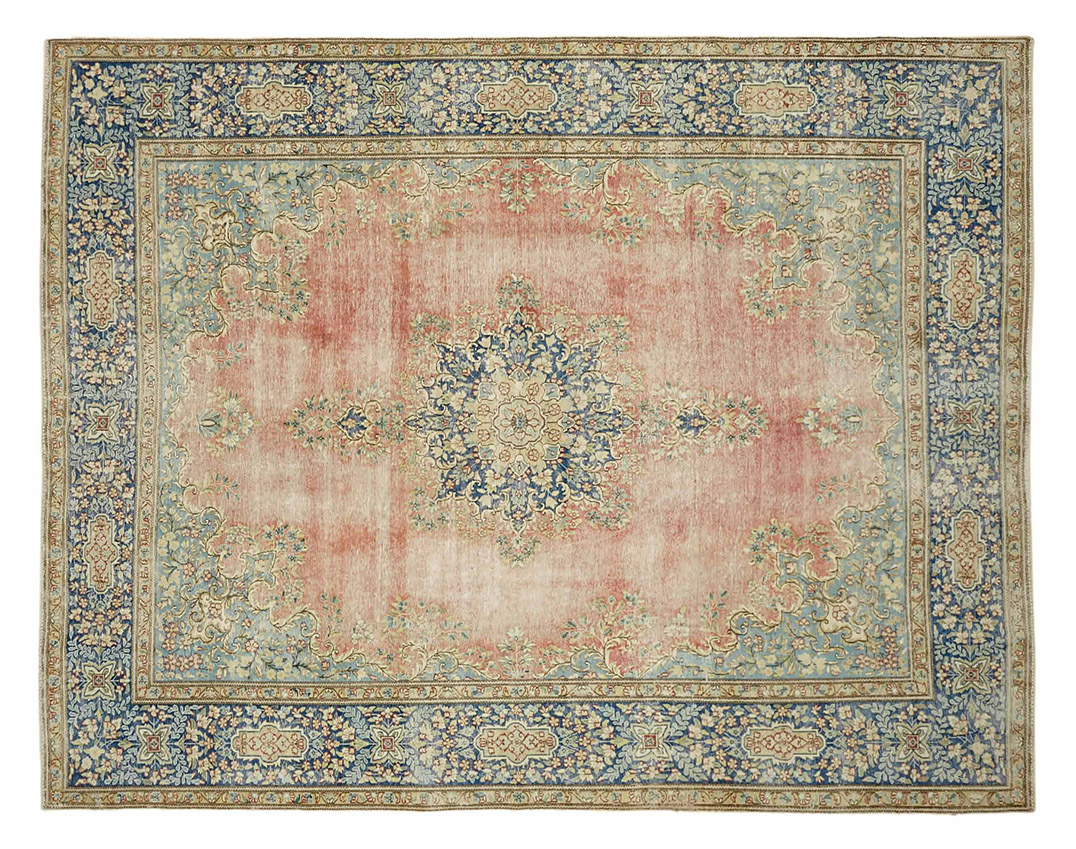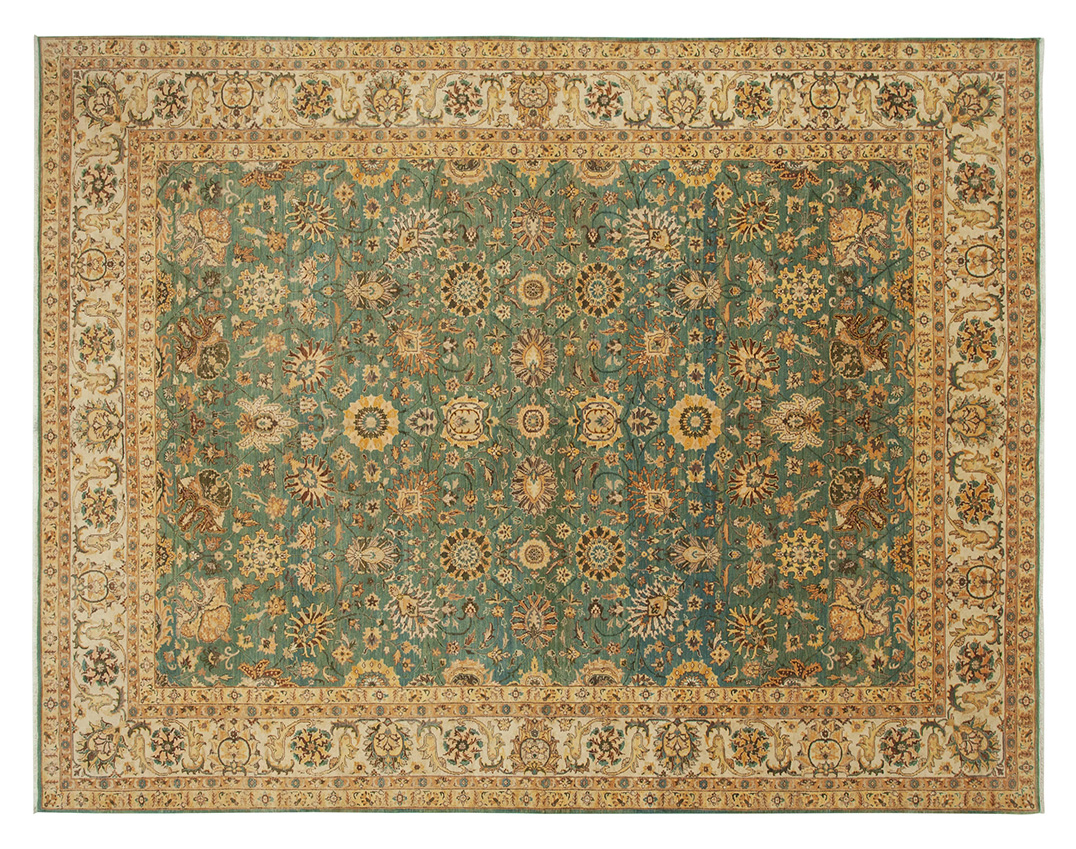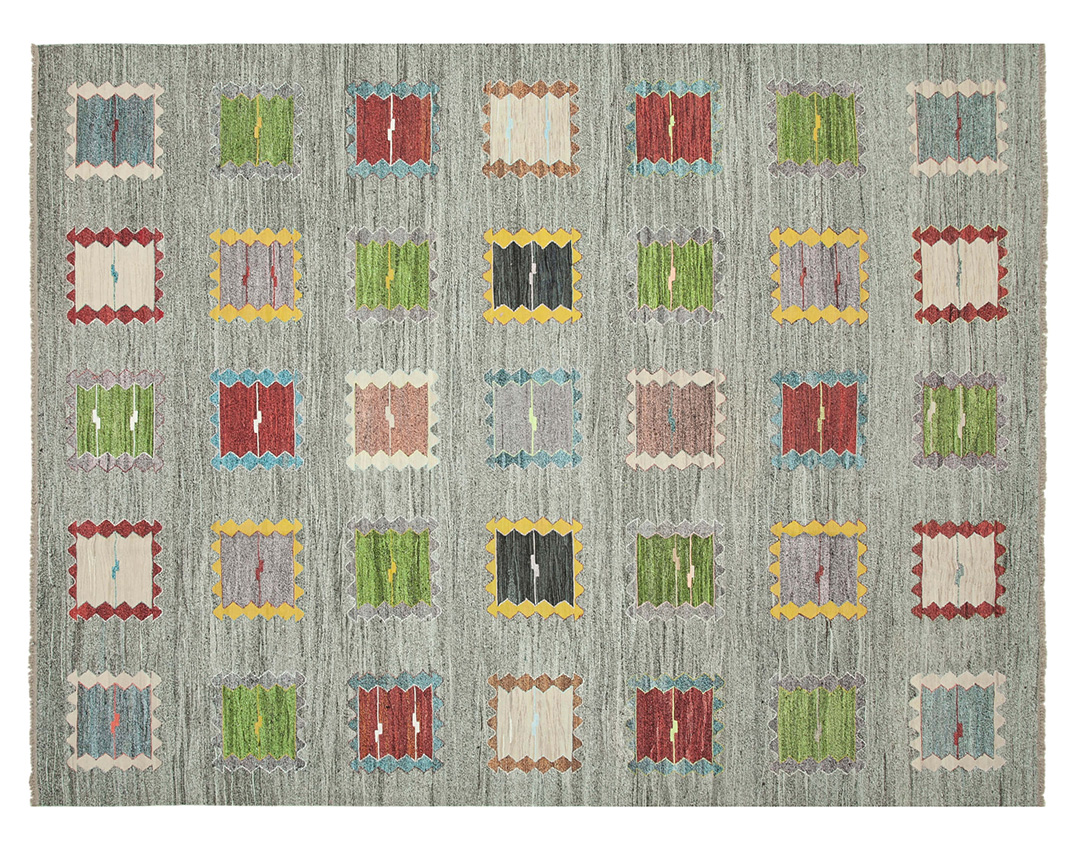The World’s Most Iconic Hand-Knotted Rug Designs: A Complete Guide

Hand-knotted rugs, especially Turkish rugs, are masterpieces of textile art, showcasing human creativity and cultural expression. Each rug tells a unique story through its intricate patterns and rich symbolism. These beautiful creations have adorned homes and palaces for centuries, from the bustling markets of Isfahan to the grand halls of European nobility.
Exploring famous rug designs like the Mina Khani with its floral motifs and the Seraband (Mir) with its diamond shapes reveals the artistry behind these patterns. By understanding these classical designs, you can:
- Make informed decisions when choosing rugs for your space
- Appreciate the cultural significance behind each pattern
- Identify authentic pieces from different regions
- Connect with centuries-old artistic traditions
Each design style, from Persian medallions to Turkish geometrics, has its own characteristics that reflect its origins and the skilled artisans who have preserved these rug weaving techniques over generations. In this article, we will explore these timeless patterns that continue to captivate designers and collectors worldwide, while also delving into the rich history of Turkish rugs and the traditional motifs in Anatolian rugs that define their unique craftsmanship.
1. Hand-knotted Persian Rugs: The Essence of Elegance and the Magic of Rug Design

Persian rugs are masterpieces of artistic expression, dating back over 2,500 years. These hand-knotted treasures emerged from ancient Persia, now modern-day Iran, where skilled artisans developed sophisticated weaving techniques passed down through generations. The rich history of these rugs is intertwined with the cultural and economic developments of the region, including the influence of the Ottoman Empire and the various Beyliks that existed during its rise.
Craftsmanship Behind Persian Rugs
The creation of Persian rugs involves meticulous attention to detail, with some pieces containing up to 1,000 knots per square inch. Natural dyes extracted from plants, insects, and minerals give these rugs their distinctive rich colors - indigo blues, deep reds, and warm earth tones that maintain their vibrancy for centuries.
Notable Persian Rug Types
Each type of hand-knotted Persian rug has its own unique characteristics:
- Heriz: Known for bold geometric patterns and sturdy construction, featuring large medallions and angular designs. This style often uses natural dyes in rug making to achieve its vibrant colors.
- Sarouk: Distinguished by their curved floral patterns and deep navy or red backgrounds, Sarouk rugs are perfect examples of traditional craftsmanship.
- Mahal: Recognized for their looser weave and larger-scale patterns, often featuring botanical designs. When considering how to choose a Turkish rug, the Mahal's unique texture is an important factor.
- Tabriz: Celebrated for their precision and intricate details, commonly displaying central medallions with corner spandrels. These rugs are made using sophisticated techniques that highlight the artistry of Persian weaving.
If you're looking to buy a Turkish rug online, it's essential to understand the distinct qualities of each type. Additionally, find tips for choosing a rug that complements your space while considering factors like material and design. And once you have your rug, be sure to explore caring for your Turkish rug properly to maintain its beauty and longevity.
Symbolism in Persian Rugs
Each Persian rug tells its own story through symbolic motifs:
- The Tree of Life representing eternal life
- The Boteh pattern symbolizing fertility
- Geometric shapes depicting protection from evil spirits
These intricate designs combine with superior craftsmanship to create rugs that appreciate in value, making them sought-after pieces for collectors and interior designers worldwide.
When exploring the world of rugs, it's essential to understand the unique character of Turkish rugs as well. These rugs made in Turkey often feature rich histories and distinctive patterns that set them apart from other styles. For those seeking a piece of this elegance in larger formats, large area rugs offer handmade options designed to elevate any home décor. Additionally, the allure of Oriental rugs, which often includes Persian styles, provides a unique blend of beauty and cultural richness that is hard to resist.
If you're interested in the benefits of Turkish rugs, consider how their craftsmanship and artistic designs can enhance your living space. Furthermore, for those looking to invest in history, Turkish antique rugs offer timeless elegance and stories woven into their fibers. And don’t forget to discover care instructions for Turkish rugs to ensure they maintain their beauty for years to come.
2. Hand-Knotted Turkish Rugs: The Legacy of Anatolian Craftsmanship
Turkish rugs are a testament to centuries of artistic evolution, dating back to the 13th century. The history of Turkish rugs is rich and varied, reflecting the diverse cultures and traditions of Anatolia. These masterpieces not only showcase intricate craftsmanship but also embody the historical significance of Turkish rugs within the region’s cultural heritage.
Anatolian rug characteristics such as vibrant colors and unique patterns tell stories passed down through generations. As you explore the types of Turkish carpets available, you'll discover how ancient weaving techniques have shaped each design, allowing you to learn about Turkish rugs history in a truly immersive way.
Whether you're looking to enhance your home with a stunning Turkish rug collection or simply wish to explore the cultural significance of Turkish carpets, these works of art offer a glimpse into the rich traditions that continue to influence modern interior design.
Celebrated Varieties of Turkish Rugs
When exploring the rich world of Turkish carpet varieties, some of the most celebrated types include:
- Oushak Rugs: These exquisite rugs are known for their silky wool and luminous colors, featuring large-scale floral patterns and medallions that add elegance to any space.
- Lotto Rugs: Distinguished by their bold geometric designs and vibrant red backgrounds, Lotto rugs are a perfect example of the diverse artistry found in traditional Turkish rugs.
If you want to learn about types of Turkish rugs, these varieties are essential representations of the craftsmanship and cultural heritage that define Turkey's rich textile history.

Distinctive Design Elements in Hand-knotted Turkish Rugs
Turkish rug artisans employ distinctive design elements that set their work apart, each rich with meaning and history. These symbolic elements in Turkish rugs reflect cultural narratives and artistic traditions:
- Rose Motif Design: This design symbolizes divine beauty and paradise, often seen in rugs influenced by Byzantine design.
- Tree of Life Design: Representing eternal life, this motif illustrates the connection between earth and heaven, highlighting the spiritual significance found in many Turkish rugs.
- Zili Design: Known for its intricate geometric patterns woven with multiple colors, the Zili design captures the eye and showcases the skill of the artisan.
- Sumak Design: Characterized by flat-woven techniques that create detailed patterns, Sumak rugs are prized for their texture and artistic depth.
- Lachak-Toranj Design: This design incorporates corner medallions with a central focal point, guiding the viewer's eye across the rug's surface.
If you're interested in exploring these unique designs further, consider visiting Turkey to find out about famous Turkish rug centers where you can experience the artistry firsthand. Additionally, understanding the benefits of Turkish rugs—such as their durability and timeless beauty—can enhance your appreciation of these remarkable works of art.
Symbolic Stories Told Through Patterns
The patterns in Turkish rugs often tell stories through symbolic elements, showcasing their versatility in modern interior design:
- Birds represent freedom and good news, adding a touch of artistic expression to contemporary spaces.
- Water symbols signify cleansing and purification, making them perfect for traditional settings while ensuring practical functionality.
- Geometric shapes express protection from evil, seamlessly integrating into various designs that balance aesthetics and meaning.
Versatility in Modern Interior Design
Turkish rugs display remarkable versatility in modern interior design, working equally well in traditional settings and contemporary spaces. Their enduring appeal lies in the perfect balance between artistic expression and practical functionality. Whether you're looking to add warmth to a minimalist room or enhance the elegance of a classic decor style, a Turkish rug can effortlessly transform any space with its rich colors and intricate patterns.
3. Handwoven Kilim Rugs vs Hand-Knotted Rugs: A Comparative Guide
Kilim rugs stand apart from traditional pile carpets through their distinctive flat-woven construction. These tapestry-style rugs originate from diverse regions across the Middle East, North Africa, and the Balkans, each area contributing unique patterns to the art form. Middle East hand-knotted rugs often feature intricate designs that reflect the rich cultural heritage of the region, while North Africa rugs are known for their vibrant colors and geometric shapes. In the Balkans, rugs like Turkish kilim showcase a variety of motifs that tell stories of local traditions and history.
Key Characteristics:
- Reversible design due to flat-weave technique
- Lightweight structure and flexible design
- Bold geometric patterns and tribal motifs
- Natural wool fibers dyed with vegetable-dyed colors
- Durable yet thinner than pile rugs
The production process involves intricate tapestry weaving, where weft threads are tightly interwoven with warp threads to create the characteristic flat surface. This technique allows artisans to craft precise geometric shapes and bold color transitions, showcasing the beauty of natural wool fibers and the richness of vegetable-dyed colors.
Popular Production Regions of Kilim Rugs:
- Anatolia (Modern-day Turkey) - Known for its rich history of weaving, Anatolia Kilim rugs are characterized by their vibrant colors and geometric patterns.
- Persian Azerbaijan - This region produces exquisite Persian Azerbaijan hand-knotted Kilim rugs that showcase intricate designs and high-quality craftsmanship.
- Afghanistan - Afghanistan Kilim rugs often feature bold motifs and a unique blend of traditional weaving techniques.
- The Caucasus - Caucasus Kilim rugs are renowned for their distinctive patterns and use of natural dyes, reflecting the cultural heritage of the region.
- Balkan Countries - In the Balkan Countries, Kilim rugs vary greatly in style but are united by their handmade quality and artistic expression.
Modern interior designers embrace Kilim rugs for their versatility and striking visual impact. You'll find these pieces adorning walls as artistic hangings, serving as statement floor coverings, or transforming into distinctive furniture upholstery. Their lightweight nature makes them ideal for layering with other rugs, creating dynamic texture combinations in contemporary spaces.
The adaptability of Kilim rugs extends to various room styles:
- Bohemian living spaces
- Minimalist modern interiors
- Rustic country homes
- Contemporary urban apartments
- Outdoor covered areas
In recent years, there's been a growing trend towards eco-friendly options like eco-friendly Kilim rugs, such as recycled Kilim rugs, which not only maintain the unique aesthetic of traditional hand-knotted Kilims but also promote sustainability.
Additionally, the charm of Aubusson and needlepoint Kilim rugs has captivated many homeowners, offering a blend of handmade elegance and intricate design that adds timeless charm to any space. These Aubusson and needlepoint Kilim rugs are perfect for those seeking quality and artistry in their interior decor.

4. Bokhara Rugs: Timeless Patterns from Pakistan
The Artisan's Touch in Bokhara Rugs
The creation of hand-knotted Bokhara rugs involves a meticulous process that showcases the exceptional skills of Pakistani artisans. Each rug undergoes multiple stages of craftsmanship:
- Wool Selection and Processing - Only premium wool from select sheep breeds is chosen
- Natural Dyeing Techniques - Traditional methods using plant-based dyes
- Hand-Knotting Process - Each knot is carefully tied following ancestral patterns
- Final Finishing - Detailed washing and trimming to enhance the rug's appearance
Regional Variations and Characteristics
Different regions in Pakistan have developed their own distinctive interpretations of Bokhara patterns:
- Peshawar Bokharas - Known for softer color palettes and larger-scale patterns
- Lahore Bokharas - Feature tighter weaves and more intricate detailing
- Multan Bokharas - Distinguished by their rich, deep red hues and traditional motifs
Quality Indicators of Fine Bokhara Rugs
When evaluating a Bokhara rug's quality, experts look for several key characteristics:
- Knot Density - Higher counts indicate superior craftsmanship
- Wool Quality - Lanolin-rich wool provides natural stain resistance
- Dye Consistency - Even coloration throughout the rug
- Pattern Symmetry - Precise alignment of motifs and borders
Contemporary Adaptations
Modern Bokhara rugs have evolved to meet changing design preferences while maintaining their traditional essence:
- Color Innovations - Introduction of neutral tones and pastel shades
- Size Variations - From small accent pieces to grand room-sized carpets
- Pattern Modifications - Subtle adaptations of classical motifs
- Material Blends - Incorporation of silk highlights for added luxury
Investment and Care Considerations
The value of Bokhara rugs often appreciates over time, particularly for pieces that demonstrate:
- Historical Significance - Age and provenance
- Technical Excellence - Superior craftsmanship and materials
- Design Integrity - Well-preserved patterns and colors
- Rarity - Unique variations or limited production pieces
Explore Other Exquisite Rug Options
If you're seeking something different yet equally exquisite, consider exploring hand-knotted Oushak rugs, known for their traditional patterns and soft tones. These decorative rugs are perfect for adding a touch of elegance to any space and enhancing your elegant interior decor. Alternatively, Moroccan rugs offer iconic Berber designs that add warmth and style to any room with their unique textures and vibrant colors.
For those who appreciate history and uniqueness, our collection of hand-knotted vintage rugs showcases timeless designs with a story behind each piece. These area rugs combine style and substance, making them perfect additions to any sophisticated decor. Additionally, if you're looking for clean lines and contemporary aesthetics, consider modern rugs that offer stylish designs to elevate your interior decor.
Whether you're interested in Turkish rug alternatives or simply want to explore diverse styles, our rug collection has something for every taste.
5. Bidjar Rugs: Durability Meets Design
Cultural Impact and Design Evolution
The cultural significance of Mamluk carpets extends beyond their aesthetic appeal, representing a crucial period in Islamic artistic development:
- Architectural Influence: Mamluk carpet designs often mirror the geometric patterns found in contemporary Islamic architecture
- Cultural Exchange: These carpets served as diplomatic gifts between rulers, facilitating artistic exchange
- Social Status: Ownership of Mamluk carpets became a symbol of wealth and refinement
Material Selection and Processing
The exceptional quality of Mamluk carpets stems from their careful material selection:
- Premium wool selection from specific breeds of sheep
- Natural dye extraction from local plants and minerals
- Specialized spinning techniques unique to Egyptian craftsmen
Regional Variations
Different regions under Mamluk rule developed distinct characteristics in their carpet production:
- Cairo Workshop Styles
- Finer knot count
- More complex geometric patterns
- Richer color palette
- Alexandria Variations
- Coastal influence in designs
- Modified color schemes
- Unique border patterns
Conservation and Collection
The preservation of Mamluk carpets requires specific expertise:
"Mamluk carpets represent some of the most technically sophisticated textile works of their era, demanding specialized conservation techniques to maintain their integrity."
Key preservation aspects include:
- Climate control requirements
- Professional cleaning protocols
- Display rotation schedules
- Documentation of pattern variations
Modern Market Impact
Contemporary appreciation for Mamluk carpets continues to grow:
- Auction house prominence
- Museum acquisition priorities
- Private collector interest
- Contemporary design inspiration
Technical Innovation
The Mamluk period introduced several technical innovations:
- Advanced Dyeing Techniques
- Multiple-bath color processes
- Color fastness improvements
- New shade combinations
- Structural Developments
- Enhanced warp tension methods
- Modified knot structures
- Improved selvage techniques
Modern Interpretations of Traditional Designs

Contemporary rug makers are redefining modern interpretations of traditional designs by using new techniques and innovative styles. These skilled craftsmen blend old patterns with abstract elements in rugs, creating pieces that resonate with current interior design tastes. By fusing history with creativity, they produce unique works that not only enhance aesthetics but also tell a story of cultural evolution.
Key Modern Design Elements:
- Deconstructed traditional motifs
- Minimalist interpretations of classic patterns
- Bold, unexpected color combinations
- Sustainable materials in rugs and production methods
The iconic Prayer Rug Design (Mihrab) serves as a perfect example of this evolution. Modern interpretations maintain the distinctive arch shape while incorporating key modern design elements like gradient colors and simplified geometric patterns. These contemporary designs often use sustainable materials to enhance both aesthetics and environmental responsibility.
Contemporary Design Approaches:
- Digital design tools for patterns creation
- Eco-friendly dyes and materials
- Mixed media techniques in rugs
- Experimental textures and weaving methods
Many contemporary designers draw inspiration from traditional Persian and Turkish patterns, transforming them into abstract compositions. These modern pieces often feature:
- Distressed traditional patterns
- Asymmetrical layouts
- Monochromatic color schemes
- Mixed cultural influences
The balance between tradition and innovation in contemporary design approaches creates unique pieces that honor historical craftsmanship while meeting modern aesthetic demands. This fusion approach has sparked interest among younger collectors and interior designers, ensuring that these ancient art forms remain relevant in contemporary spaces.



























